Persimmons (Perceptions Change Slowly)
PERSIMMONS
(Perceptions Change Slowly)

Fuyu (Jiro) Persimmon (#1 seller)
There has been confusion on persimmons. Our United States American persimmon was not very edible so the market production of fruit was slow and the public showed no interest to sample.
Japan and China grew the persimmon and the Japanese sold them in Europe. By the time these arrived in California, the names were mixed and new crosses and rootstock confusion.
Orange County Nursery became the major persimmon grower for the United States nurseries. The L. E. Cooke bought from Orange County into the 1970’s, as did most all others. The Orange County owners made trips to Japan to bring back new selections.
California through UC Davis and the Persimmon Association brought in Kay Ryugo for most of a year to study all the California persimmons. The persimmon we were and still sell for Fuyu (Jiro) Persimmon is what he called a “California Fuyu”. No need to change because all farmers know it as Fuyu (Jiro).
Unfortunately the early market persimmons were the American or Hachiya which need to be eaten fully ripe or it was very astringent. Even still today, many people are hesitant to eat a persimmon. Persimmons are now well accepted in California, but most of the rest of the country only knows or heard about the American or Hachiya. I am amazed at the nursery people who will not sell a persimmon because of the “bitter” fruit. If you visit the L. E. Cooke Co in the fall, I attempt to have a visitor sample a Fuyu Persimmon. What a surprise when they want to take a box of fruit home.
We brought seven varieties from Japan to avoid some of the confusion and uncertainty of names in California sources. Several were lost in travel and quarantine. All were here previously so we did not “introduce” any except for FUYU (IMOTO) PERSIMMON. The facts are basically the same as Fuyu (Jiro) except a little larger and about 7-10 days earlier. The Imoto selection came from the late Mr. Mike Imoto in Lindsay. We grew it for him and he allowed the company to add it to our catalog. I assume Imoto is a California Fuyu sport.
The Fuyu (Imoto) Persimmon advantage is slightly larger and earlier fruiting.
The L. E. Cooke Co introduced Fuyu (Imoto) in 1985.
Bob Ludekens
Information Page for Fuyu (Imoto) Persimmon
Health Benefits of Persimmons

PERSIMMONS
Persimmons have a wealth of health benefits packed in side them.
Persimmons, like most fruits, are high in dietary fiber. High fiber fruits boost the gastrointestinal system and help protect against colorectal cancer and similar ailments. They also reduce lipid uptake and assist in weight loss.
Persimmons contain betulinic acid which is a proven anti-tumor compound that plays a part in prevention and/or reduction of tumor development.
Vitamin rich persimmons contain vitamin A, beta-carotene, lutein, lycopene, cryptoxanthin. These function as anti-oxidants reducing oxidative stress and prevent premature aging conditions such as wrinkles, age spots, Alzheimer's, fatigue, poor vision, and weak muscle tone.
Persimmons contain potassium and other vasodilators that increase blood flow and lower blood pressure. Persimmons work so well in this capacity that people with hypotension should use caution when eating because their blood pressure may become dangerously low.
Persimmons also contain copper, essential in the formation of new red blood cells. Increased circulation of new red blood cells increases cognitive function, metabolism, cellular growth and wound repair.
The zea-xanthin in persimmons is linked to good eye heath reducing macular degeneration, cataracts, and night blindness.
Tom Fetch 1-26-2014
The information I am sharing is from a multitude of sources, and cultures over a wide time span. Neither L. E. Cooke Co. nor I as a representative assume any liability concerning the efficacy of the information shared. We do not suggest that any dietary protocols discussed are to replace conventional medical treatment or guarantee any results by their practice. We are nurserymen, not MDs, and proud of the trees we grow and the enhancements to life they provide.
Fall Colors
Every season has its attractions to a photographer, but fall usually is one of our favorites. The reds, golds and yellows displayed in nature attest to the creative side of God for our pleasure. Many of you live in absolutely stunning areas where fall color is rampant and even the travel industry thrives catering to the "leaf peepers".
And a lot of us live in a more subdued environment where we are tickled when we can plant a variety that gives us an additional season of enjoyment.
Here are a few of the items we grow that provides the color palette we like to enjoy:
Reds & Oranges
Chinese Pistache
My neighborhood has a lot of Chinese Pistache - both the seedling (with seeds) and the seedless Keith Davies. Here are some shots from last Saturday's walk around the block.
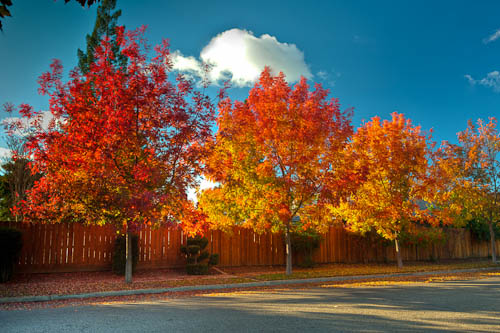
Seedling Chinese Pistache - Great Oranges and Reds - but colors will vary since each tree came from seed.
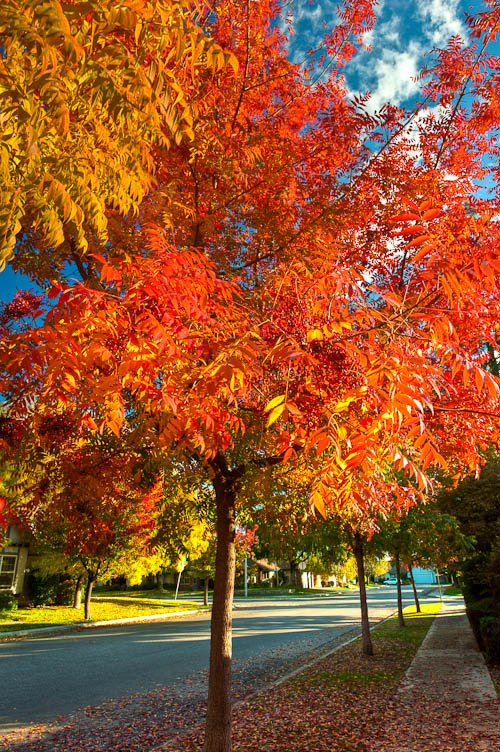
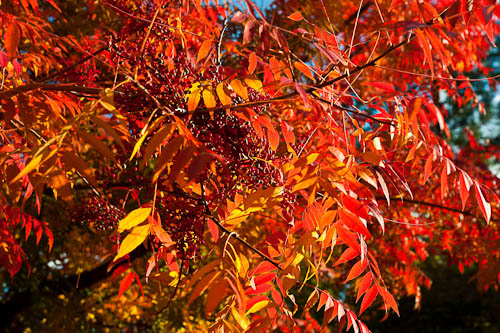
Look close and you can see the red seeds among the foliage. Pretty but slippery on the cement sidewalks which is why I like the Keith Davies.
Persimmons
Most people only think of the orange-red fruit of the persimmons which ripen in the fall and provide their own fall ornamental value along with good eating.
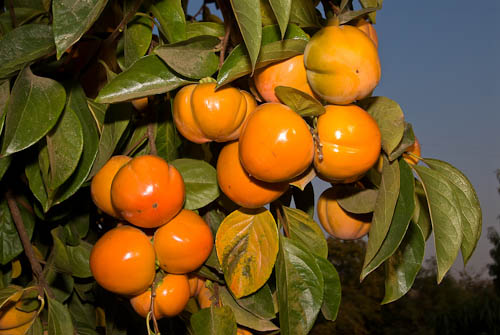
Many persimmons also have colorful fall foliage:
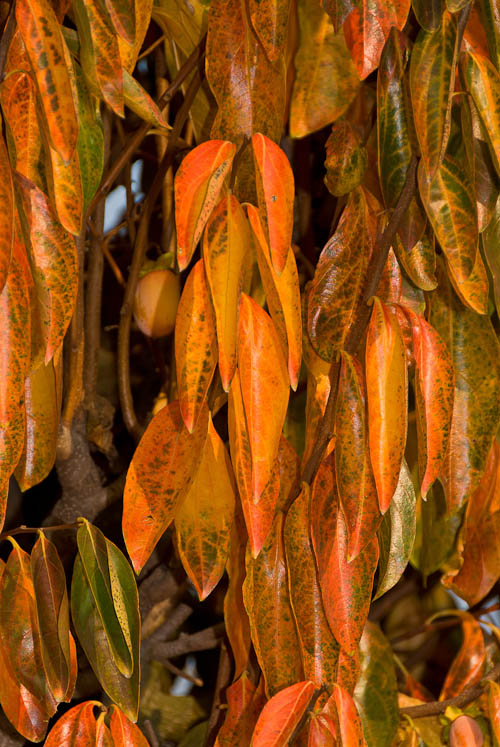
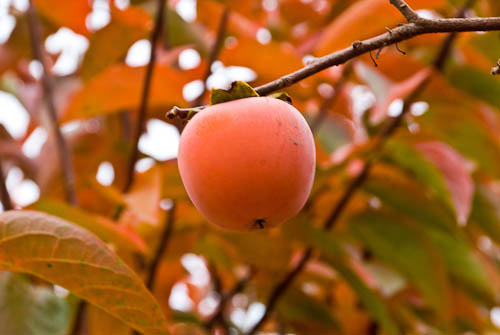
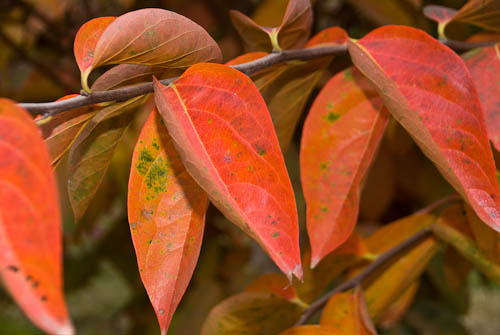
Forest Pansy Redbud
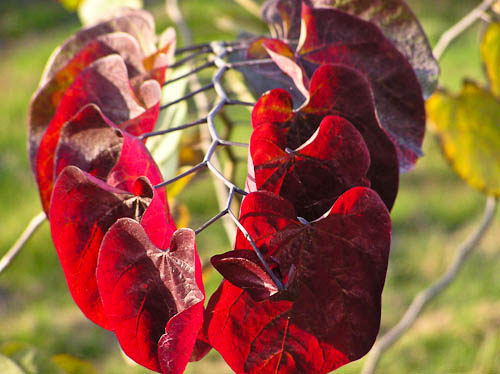
This November photo shows the new growth still vibrantly red. Older foliage is turning a non-spectacular yellow.
Trident Maple (Acer buergeranum) Our environment, like many of yours, is not conducive to successfully growing many of the great maples seen in the acidic soils of the east. I like the Trident Maple because it is a tough tree that handles our slightly alkaline soils and high summer temperatures. It provides good fall color as well.
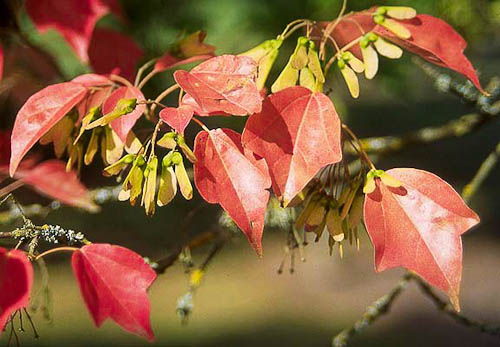
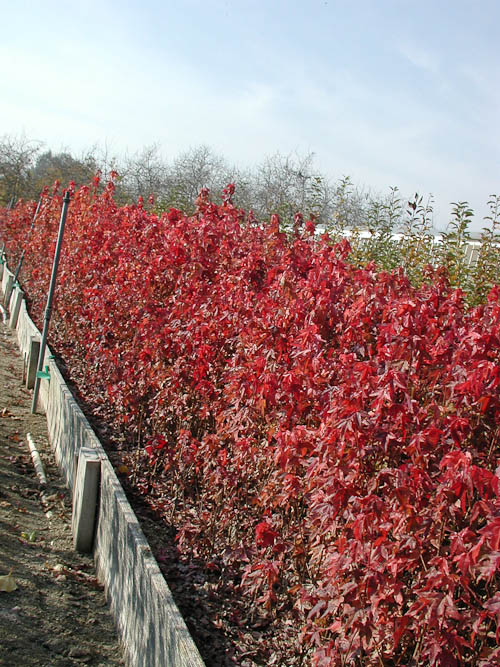
Seed bed full of Trident Maple (Acer buergeranum) seedlings showing red fall color.
Autumn Fantasy Maple
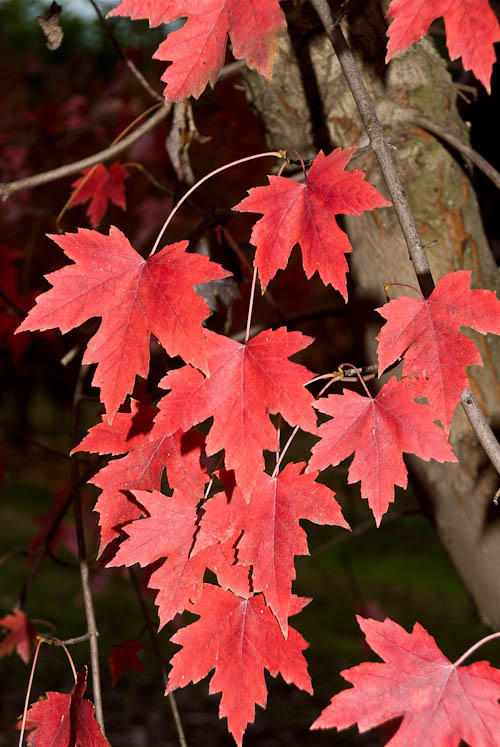
Golds & Yellows
European White Birch
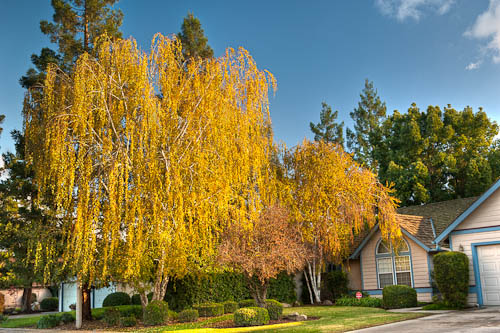
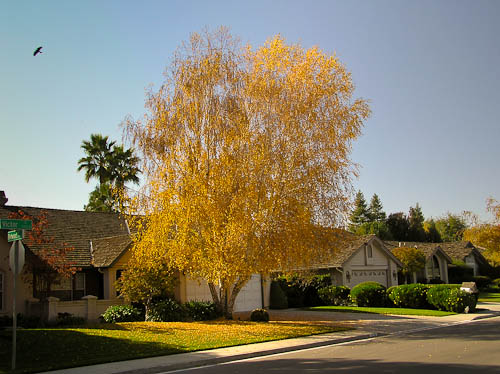
There are several plantings of Clump European White Birth (Betula pendula alba) in my neighborhood which provide attractive golden fall color.
Golden Desert Ash
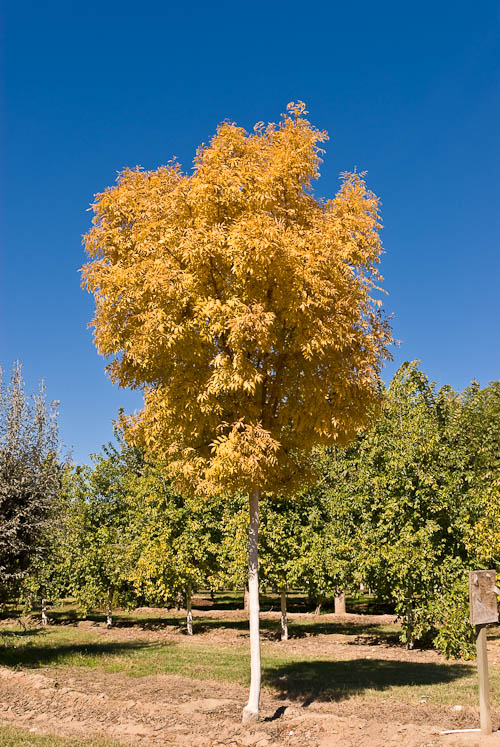
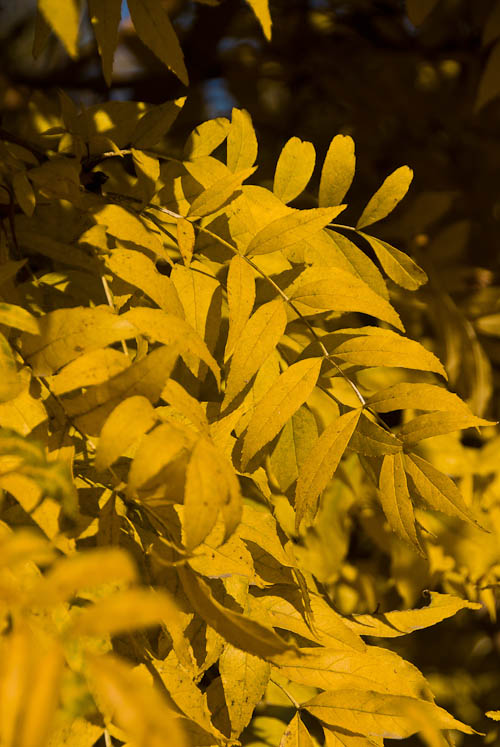
All summer long the Golden Desert Ash has a nice golden color which is especially showy against a green backdrop. In the fall, the golds turn even more golden.
Populus
Basically all the Populus family has attractive golden-yellow fall colors and there is not enough room to show them all here. I want to feature the Silver Leafed Poplars that have attractive green/silver summer foliage that turns into a stunning golden show in the fall.
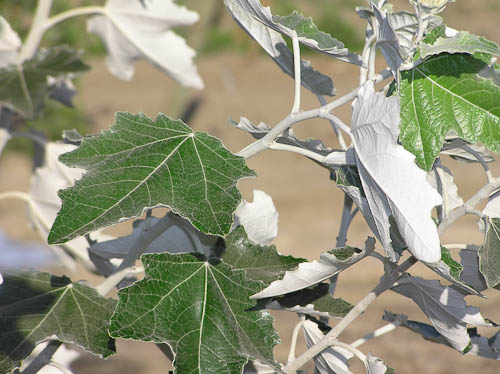
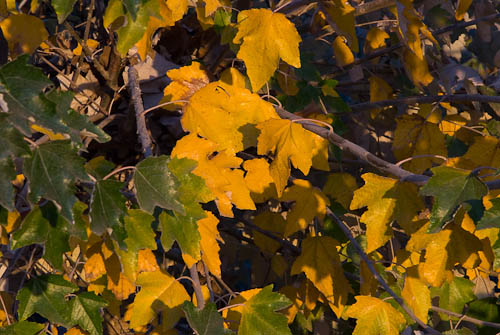
Autumn Purple Ash
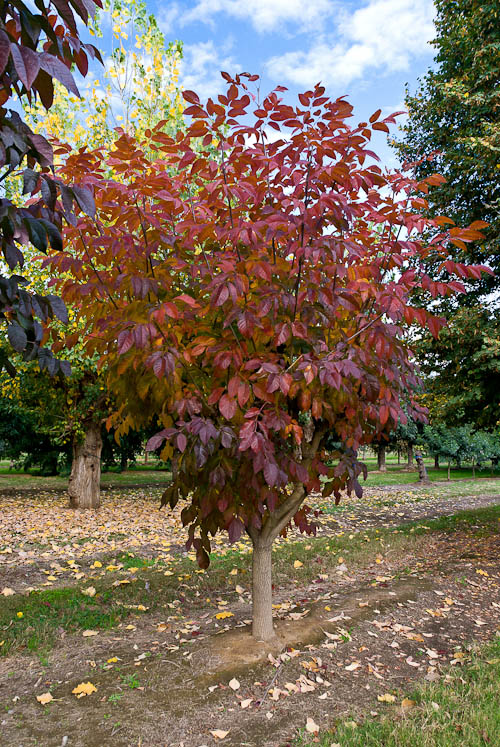
(Ignore the shape - this is a tree we butcher yearly to get budwood - use your imagination)
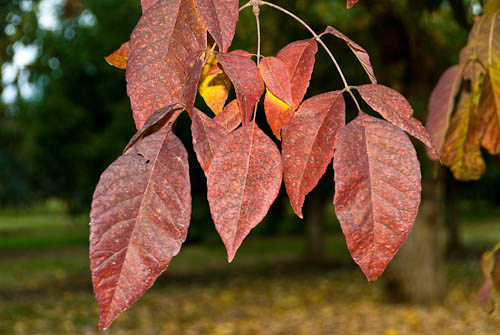
Autumn Purple Ash has attractive fall colors in the burgundy-purple ranges. This tree is an excellent shade tree in the summer and should have wider use.
And this was a brief photo walk around the block and a brief stop in the budwood orchard. What colors do you want to add to your landscape to enjoy for many years to come?
Ron Ludekens 11-20-2010
Persimmon Fruit Drop
Homeowners often call their local nursery with a question: Why does my Persimmon Tree drop its fruit at an immature stage?
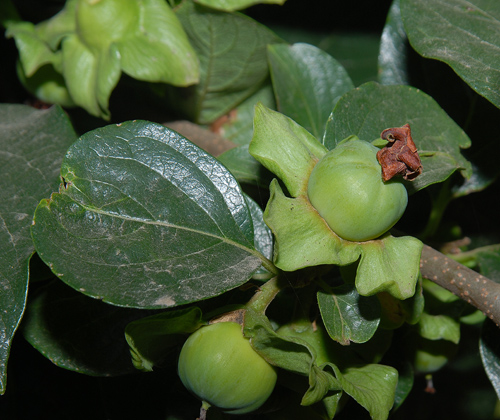 Juvenile Persimmons
Juvenile Persimmons
On a mature tree, first choice is often excess nitrogen/fertilizers. Second is over watering. Most often I see the problem with Persimmons planted in a lawn where both happen. A third option is not enough sun - planted in too much shade.
More indepth information can be found at these links:
Plant Forum on Persimmon Fertilizing
Another area to consider - a young persimmon is not going to produce very tasty fruit until it is a few years old. A heavy set of fruit on a young tree steals the nutrients needed for growing the tree and puts it into fruit growth. A wise person who wants a more mature tree sooner would strip off the fruit for a few years and enjoy the feast the 3rd and later years. If nothing else, he should radically thin the fruit on that young tree.

